Business Law Report: Analysis of Sale of Goods, Credit, and Agency
VerifiedAdded on 2020/02/03
|14
|5450
|60
Report
AI Summary
This report provides a comprehensive analysis of business law principles, focusing on the sale of goods, consumer credit, and agency. Task 1 delves into the legal rules surrounding implied terms in the context of the sale of goods and supply of services, examining statutory provisions on the transfer of property and possession, and evaluating buyer's and seller's remedies, as well as product liability. Task 2 explores the types of credit available to consumers, legal rules on termination rights and default notices, general features of agency, and the rights and duties of agents. The report also includes an essay in Task 3 and a concluding section summarizing the key findings. The case study revolves around a consumer, Ben, and his purchase of a used car, illustrating various aspects of business law in practice. The report references relevant legal acts and scholarly articles to support its analysis.
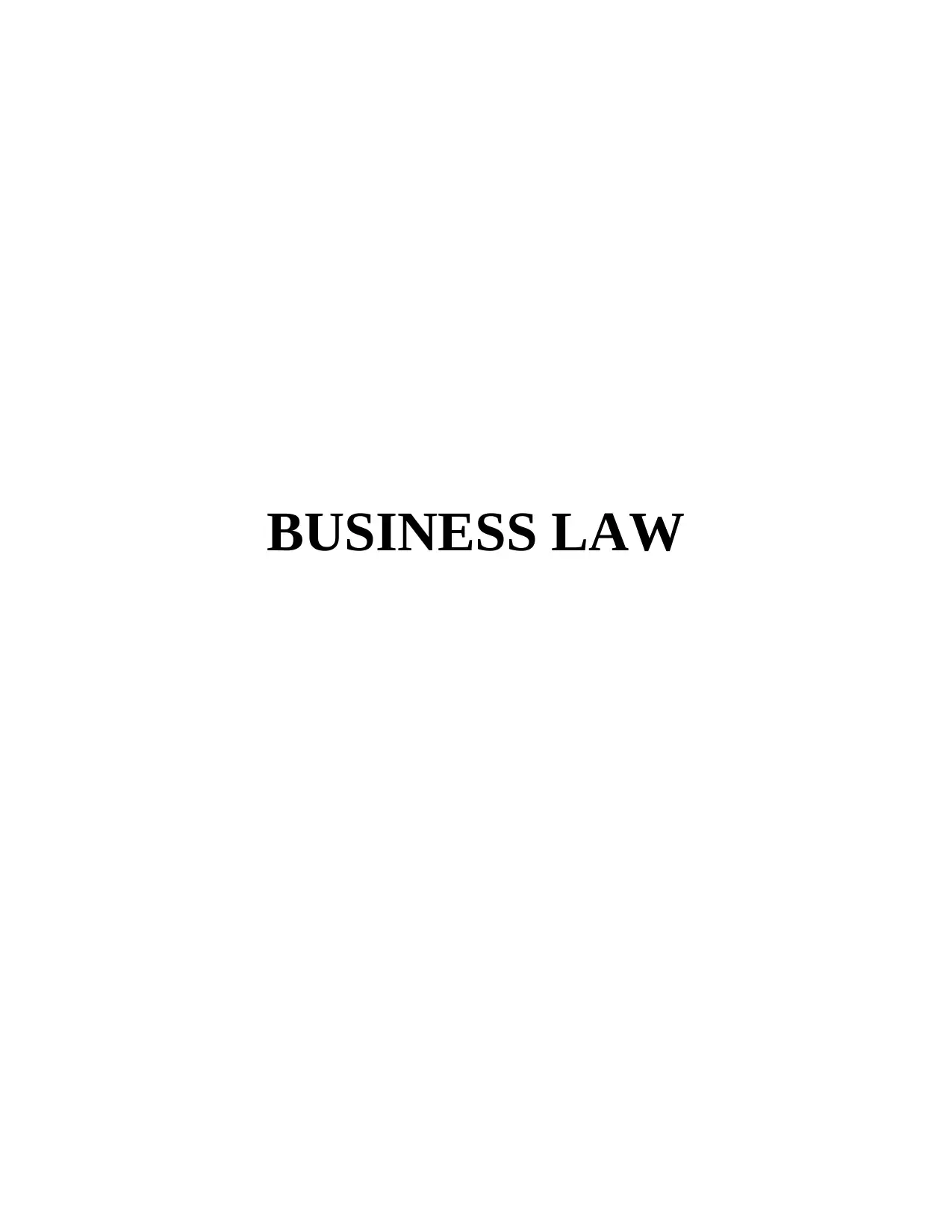
BUSINESS LAW
Paraphrase This Document
Need a fresh take? Get an instant paraphrase of this document with our AI Paraphraser
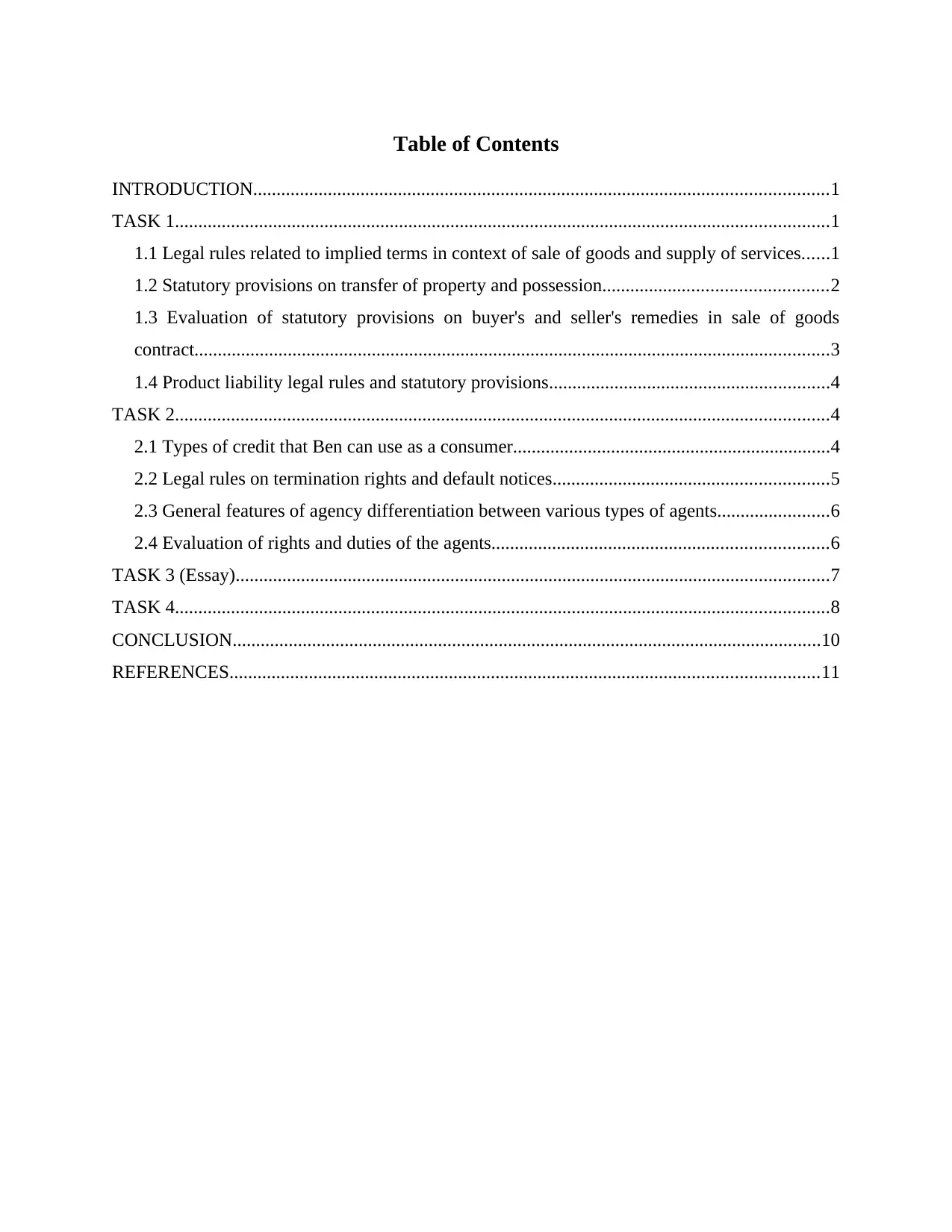
Table of Contents
INTRODUCTION...........................................................................................................................1
TASK 1............................................................................................................................................1
1.1 Legal rules related to implied terms in context of sale of goods and supply of services......1
1.2 Statutory provisions on transfer of property and possession................................................2
1.3 Evaluation of statutory provisions on buyer's and seller's remedies in sale of goods
contract........................................................................................................................................3
1.4 Product liability legal rules and statutory provisions............................................................4
TASK 2............................................................................................................................................4
2.1 Types of credit that Ben can use as a consumer....................................................................4
2.2 Legal rules on termination rights and default notices...........................................................5
2.3 General features of agency differentiation between various types of agents........................6
2.4 Evaluation of rights and duties of the agents........................................................................6
TASK 3 (Essay)...............................................................................................................................7
TASK 4............................................................................................................................................8
CONCLUSION..............................................................................................................................10
REFERENCES..............................................................................................................................11
INTRODUCTION...........................................................................................................................1
TASK 1............................................................................................................................................1
1.1 Legal rules related to implied terms in context of sale of goods and supply of services......1
1.2 Statutory provisions on transfer of property and possession................................................2
1.3 Evaluation of statutory provisions on buyer's and seller's remedies in sale of goods
contract........................................................................................................................................3
1.4 Product liability legal rules and statutory provisions............................................................4
TASK 2............................................................................................................................................4
2.1 Types of credit that Ben can use as a consumer....................................................................4
2.2 Legal rules on termination rights and default notices...........................................................5
2.3 General features of agency differentiation between various types of agents........................6
2.4 Evaluation of rights and duties of the agents........................................................................6
TASK 3 (Essay)...............................................................................................................................7
TASK 4............................................................................................................................................8
CONCLUSION..............................................................................................................................10
REFERENCES..............................................................................................................................11
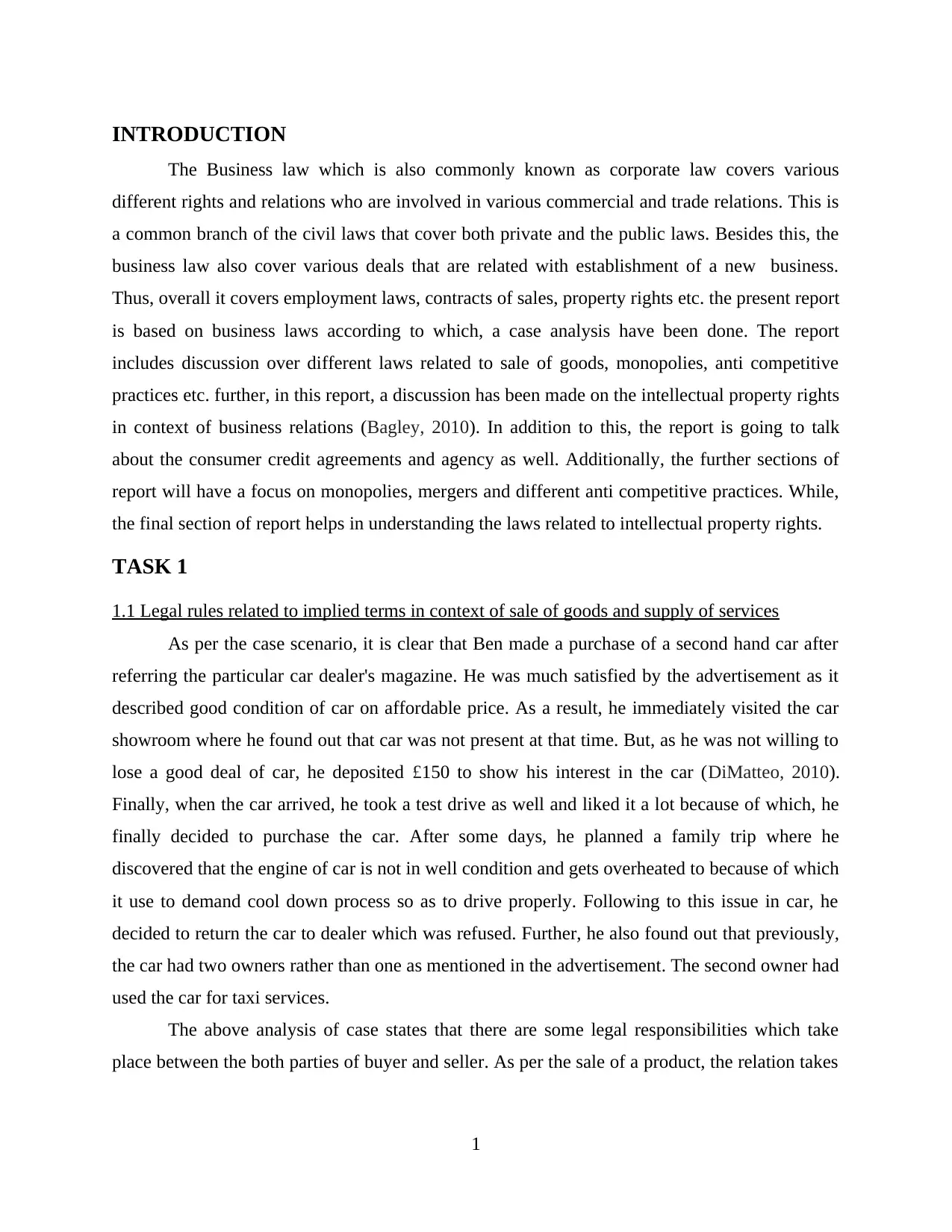
INTRODUCTION
The Business law which is also commonly known as corporate law covers various
different rights and relations who are involved in various commercial and trade relations. This is
a common branch of the civil laws that cover both private and the public laws. Besides this, the
business law also cover various deals that are related with establishment of a new business.
Thus, overall it covers employment laws, contracts of sales, property rights etc. the present report
is based on business laws according to which, a case analysis have been done. The report
includes discussion over different laws related to sale of goods, monopolies, anti competitive
practices etc. further, in this report, a discussion has been made on the intellectual property rights
in context of business relations (Bagley, 2010). In addition to this, the report is going to talk
about the consumer credit agreements and agency as well. Additionally, the further sections of
report will have a focus on monopolies, mergers and different anti competitive practices. While,
the final section of report helps in understanding the laws related to intellectual property rights.
TASK 1
1.1 Legal rules related to implied terms in context of sale of goods and supply of services
As per the case scenario, it is clear that Ben made a purchase of a second hand car after
referring the particular car dealer's magazine. He was much satisfied by the advertisement as it
described good condition of car on affordable price. As a result, he immediately visited the car
showroom where he found out that car was not present at that time. But, as he was not willing to
lose a good deal of car, he deposited £150 to show his interest in the car (DiMatteo, 2010).
Finally, when the car arrived, he took a test drive as well and liked it a lot because of which, he
finally decided to purchase the car. After some days, he planned a family trip where he
discovered that the engine of car is not in well condition and gets overheated to because of which
it use to demand cool down process so as to drive properly. Following to this issue in car, he
decided to return the car to dealer which was refused. Further, he also found out that previously,
the car had two owners rather than one as mentioned in the advertisement. The second owner had
used the car for taxi services.
The above analysis of case states that there are some legal responsibilities which take
place between the both parties of buyer and seller. As per the sale of a product, the relation takes
1
The Business law which is also commonly known as corporate law covers various
different rights and relations who are involved in various commercial and trade relations. This is
a common branch of the civil laws that cover both private and the public laws. Besides this, the
business law also cover various deals that are related with establishment of a new business.
Thus, overall it covers employment laws, contracts of sales, property rights etc. the present report
is based on business laws according to which, a case analysis have been done. The report
includes discussion over different laws related to sale of goods, monopolies, anti competitive
practices etc. further, in this report, a discussion has been made on the intellectual property rights
in context of business relations (Bagley, 2010). In addition to this, the report is going to talk
about the consumer credit agreements and agency as well. Additionally, the further sections of
report will have a focus on monopolies, mergers and different anti competitive practices. While,
the final section of report helps in understanding the laws related to intellectual property rights.
TASK 1
1.1 Legal rules related to implied terms in context of sale of goods and supply of services
As per the case scenario, it is clear that Ben made a purchase of a second hand car after
referring the particular car dealer's magazine. He was much satisfied by the advertisement as it
described good condition of car on affordable price. As a result, he immediately visited the car
showroom where he found out that car was not present at that time. But, as he was not willing to
lose a good deal of car, he deposited £150 to show his interest in the car (DiMatteo, 2010).
Finally, when the car arrived, he took a test drive as well and liked it a lot because of which, he
finally decided to purchase the car. After some days, he planned a family trip where he
discovered that the engine of car is not in well condition and gets overheated to because of which
it use to demand cool down process so as to drive properly. Following to this issue in car, he
decided to return the car to dealer which was refused. Further, he also found out that previously,
the car had two owners rather than one as mentioned in the advertisement. The second owner had
used the car for taxi services.
The above analysis of case states that there are some legal responsibilities which take
place between the both parties of buyer and seller. As per the sale of a product, the relation takes
1
⊘ This is a preview!⊘
Do you want full access?
Subscribe today to unlock all pages.

Trusted by 1+ million students worldwide
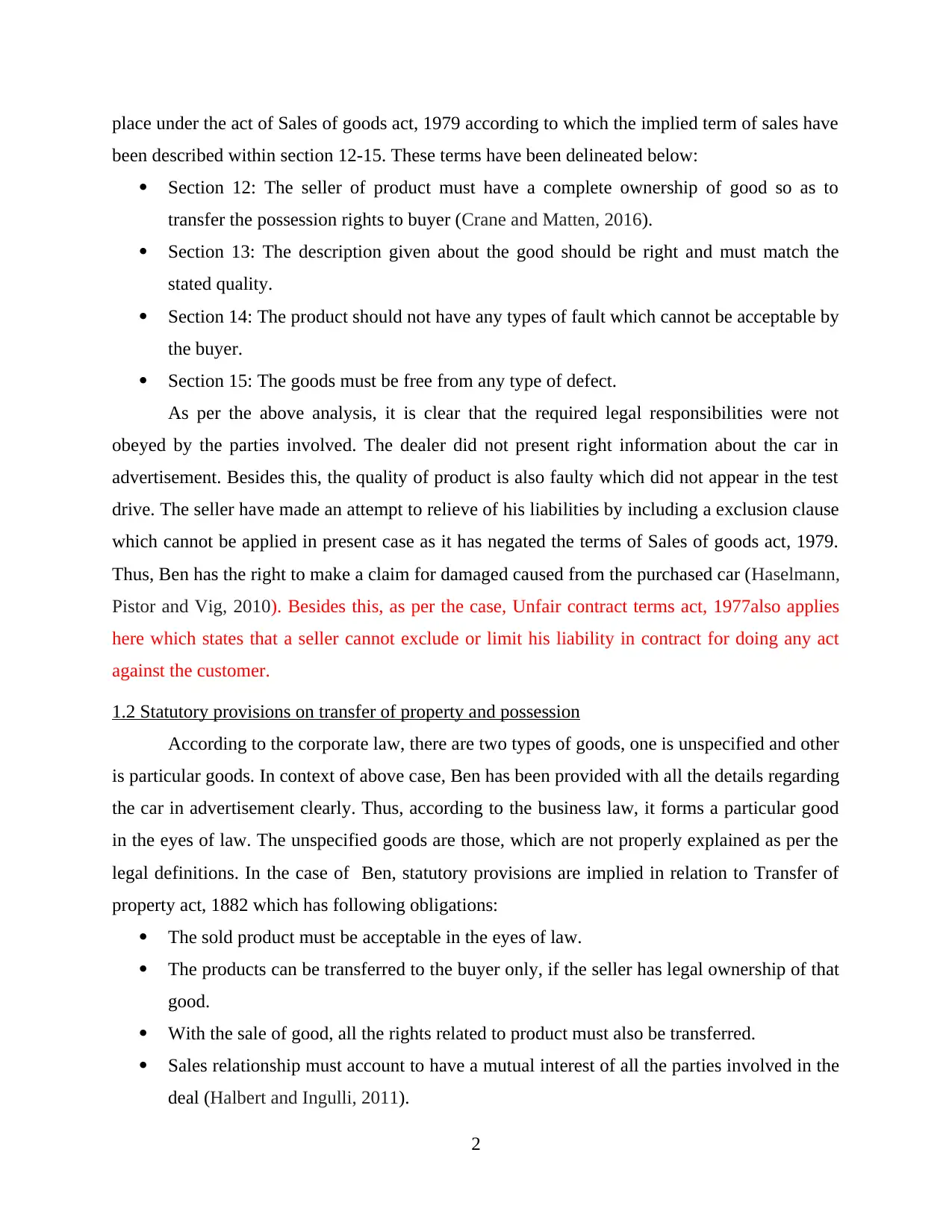
place under the act of Sales of goods act, 1979 according to which the implied term of sales have
been described within section 12-15. These terms have been delineated below:
Section 12: The seller of product must have a complete ownership of good so as to
transfer the possession rights to buyer (Crane and Matten, 2016).
Section 13: The description given about the good should be right and must match the
stated quality.
Section 14: The product should not have any types of fault which cannot be acceptable by
the buyer.
Section 15: The goods must be free from any type of defect.
As per the above analysis, it is clear that the required legal responsibilities were not
obeyed by the parties involved. The dealer did not present right information about the car in
advertisement. Besides this, the quality of product is also faulty which did not appear in the test
drive. The seller have made an attempt to relieve of his liabilities by including a exclusion clause
which cannot be applied in present case as it has negated the terms of Sales of goods act, 1979.
Thus, Ben has the right to make a claim for damaged caused from the purchased car (Haselmann,
Pistor and Vig, 2010). Besides this, as per the case, Unfair contract terms act, 1977also applies
here which states that a seller cannot exclude or limit his liability in contract for doing any act
against the customer.
1.2 Statutory provisions on transfer of property and possession
According to the corporate law, there are two types of goods, one is unspecified and other
is particular goods. In context of above case, Ben has been provided with all the details regarding
the car in advertisement clearly. Thus, according to the business law, it forms a particular good
in the eyes of law. The unspecified goods are those, which are not properly explained as per the
legal definitions. In the case of Ben, statutory provisions are implied in relation to Transfer of
property act, 1882 which has following obligations:
The sold product must be acceptable in the eyes of law.
The products can be transferred to the buyer only, if the seller has legal ownership of that
good.
With the sale of good, all the rights related to product must also be transferred.
Sales relationship must account to have a mutual interest of all the parties involved in the
deal (Halbert and Ingulli, 2011).
2
been described within section 12-15. These terms have been delineated below:
Section 12: The seller of product must have a complete ownership of good so as to
transfer the possession rights to buyer (Crane and Matten, 2016).
Section 13: The description given about the good should be right and must match the
stated quality.
Section 14: The product should not have any types of fault which cannot be acceptable by
the buyer.
Section 15: The goods must be free from any type of defect.
As per the above analysis, it is clear that the required legal responsibilities were not
obeyed by the parties involved. The dealer did not present right information about the car in
advertisement. Besides this, the quality of product is also faulty which did not appear in the test
drive. The seller have made an attempt to relieve of his liabilities by including a exclusion clause
which cannot be applied in present case as it has negated the terms of Sales of goods act, 1979.
Thus, Ben has the right to make a claim for damaged caused from the purchased car (Haselmann,
Pistor and Vig, 2010). Besides this, as per the case, Unfair contract terms act, 1977also applies
here which states that a seller cannot exclude or limit his liability in contract for doing any act
against the customer.
1.2 Statutory provisions on transfer of property and possession
According to the corporate law, there are two types of goods, one is unspecified and other
is particular goods. In context of above case, Ben has been provided with all the details regarding
the car in advertisement clearly. Thus, according to the business law, it forms a particular good
in the eyes of law. The unspecified goods are those, which are not properly explained as per the
legal definitions. In the case of Ben, statutory provisions are implied in relation to Transfer of
property act, 1882 which has following obligations:
The sold product must be acceptable in the eyes of law.
The products can be transferred to the buyer only, if the seller has legal ownership of that
good.
With the sale of good, all the rights related to product must also be transferred.
Sales relationship must account to have a mutual interest of all the parties involved in the
deal (Halbert and Ingulli, 2011).
2
Paraphrase This Document
Need a fresh take? Get an instant paraphrase of this document with our AI Paraphraser
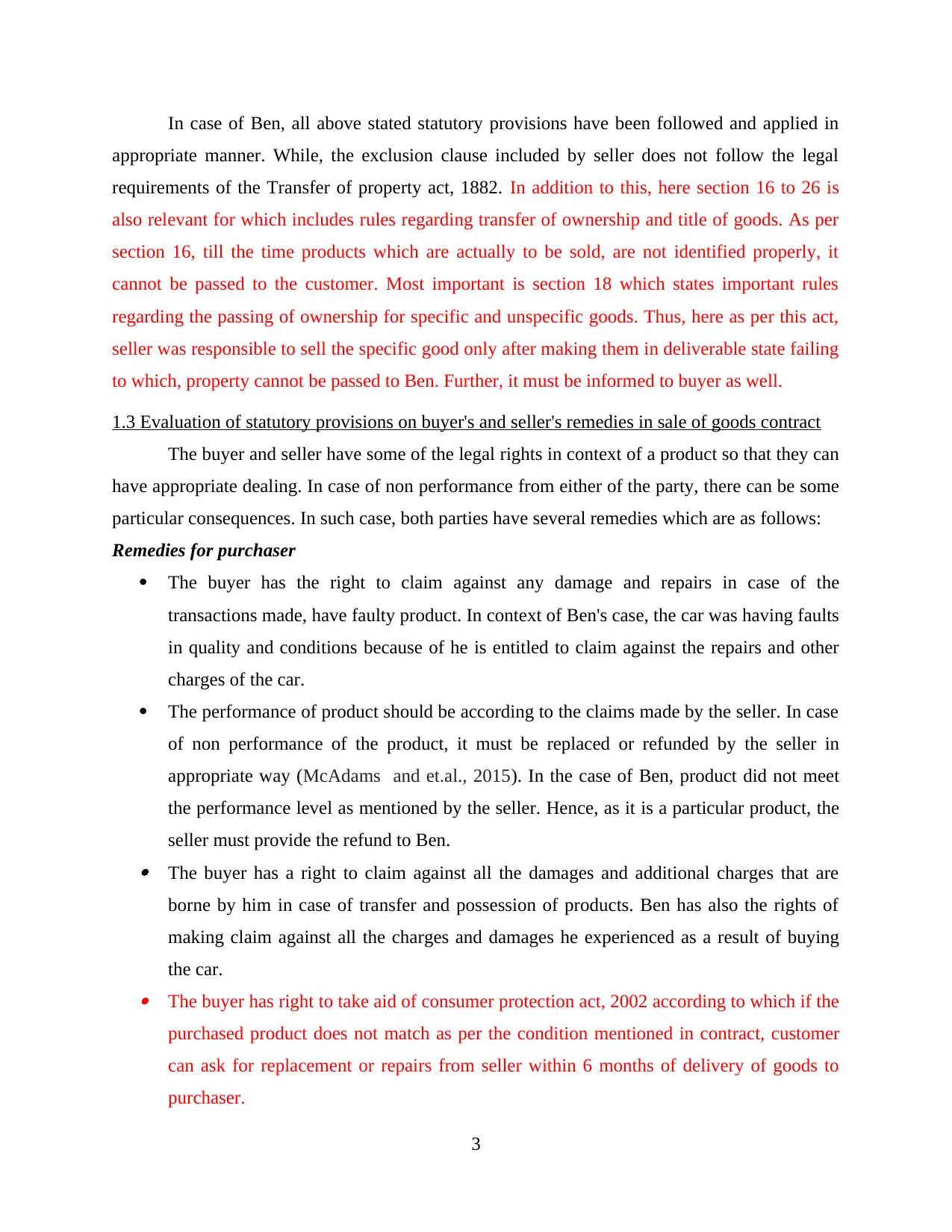
In case of Ben, all above stated statutory provisions have been followed and applied in
appropriate manner. While, the exclusion clause included by seller does not follow the legal
requirements of the Transfer of property act, 1882. In addition to this, here section 16 to 26 is
also relevant for which includes rules regarding transfer of ownership and title of goods. As per
section 16, till the time products which are actually to be sold, are not identified properly, it
cannot be passed to the customer. Most important is section 18 which states important rules
regarding the passing of ownership for specific and unspecific goods. Thus, here as per this act,
seller was responsible to sell the specific good only after making them in deliverable state failing
to which, property cannot be passed to Ben. Further, it must be informed to buyer as well.
1.3 Evaluation of statutory provisions on buyer's and seller's remedies in sale of goods contract
The buyer and seller have some of the legal rights in context of a product so that they can
have appropriate dealing. In case of non performance from either of the party, there can be some
particular consequences. In such case, both parties have several remedies which are as follows:
Remedies for purchaser
The buyer has the right to claim against any damage and repairs in case of the
transactions made, have faulty product. In context of Ben's case, the car was having faults
in quality and conditions because of he is entitled to claim against the repairs and other
charges of the car.
The performance of product should be according to the claims made by the seller. In case
of non performance of the product, it must be replaced or refunded by the seller in
appropriate way (McAdams and et.al., 2015). In the case of Ben, product did not meet
the performance level as mentioned by the seller. Hence, as it is a particular product, the
seller must provide the refund to Ben. The buyer has a right to claim against all the damages and additional charges that are
borne by him in case of transfer and possession of products. Ben has also the rights of
making claim against all the charges and damages he experienced as a result of buying
the car. The buyer has right to take aid of consumer protection act, 2002 according to which if the
purchased product does not match as per the condition mentioned in contract, customer
can ask for replacement or repairs from seller within 6 months of delivery of goods to
purchaser.
3
appropriate manner. While, the exclusion clause included by seller does not follow the legal
requirements of the Transfer of property act, 1882. In addition to this, here section 16 to 26 is
also relevant for which includes rules regarding transfer of ownership and title of goods. As per
section 16, till the time products which are actually to be sold, are not identified properly, it
cannot be passed to the customer. Most important is section 18 which states important rules
regarding the passing of ownership for specific and unspecific goods. Thus, here as per this act,
seller was responsible to sell the specific good only after making them in deliverable state failing
to which, property cannot be passed to Ben. Further, it must be informed to buyer as well.
1.3 Evaluation of statutory provisions on buyer's and seller's remedies in sale of goods contract
The buyer and seller have some of the legal rights in context of a product so that they can
have appropriate dealing. In case of non performance from either of the party, there can be some
particular consequences. In such case, both parties have several remedies which are as follows:
Remedies for purchaser
The buyer has the right to claim against any damage and repairs in case of the
transactions made, have faulty product. In context of Ben's case, the car was having faults
in quality and conditions because of he is entitled to claim against the repairs and other
charges of the car.
The performance of product should be according to the claims made by the seller. In case
of non performance of the product, it must be replaced or refunded by the seller in
appropriate way (McAdams and et.al., 2015). In the case of Ben, product did not meet
the performance level as mentioned by the seller. Hence, as it is a particular product, the
seller must provide the refund to Ben. The buyer has a right to claim against all the damages and additional charges that are
borne by him in case of transfer and possession of products. Ben has also the rights of
making claim against all the charges and damages he experienced as a result of buying
the car. The buyer has right to take aid of consumer protection act, 2002 according to which if the
purchased product does not match as per the condition mentioned in contract, customer
can ask for replacement or repairs from seller within 6 months of delivery of goods to
purchaser.
3
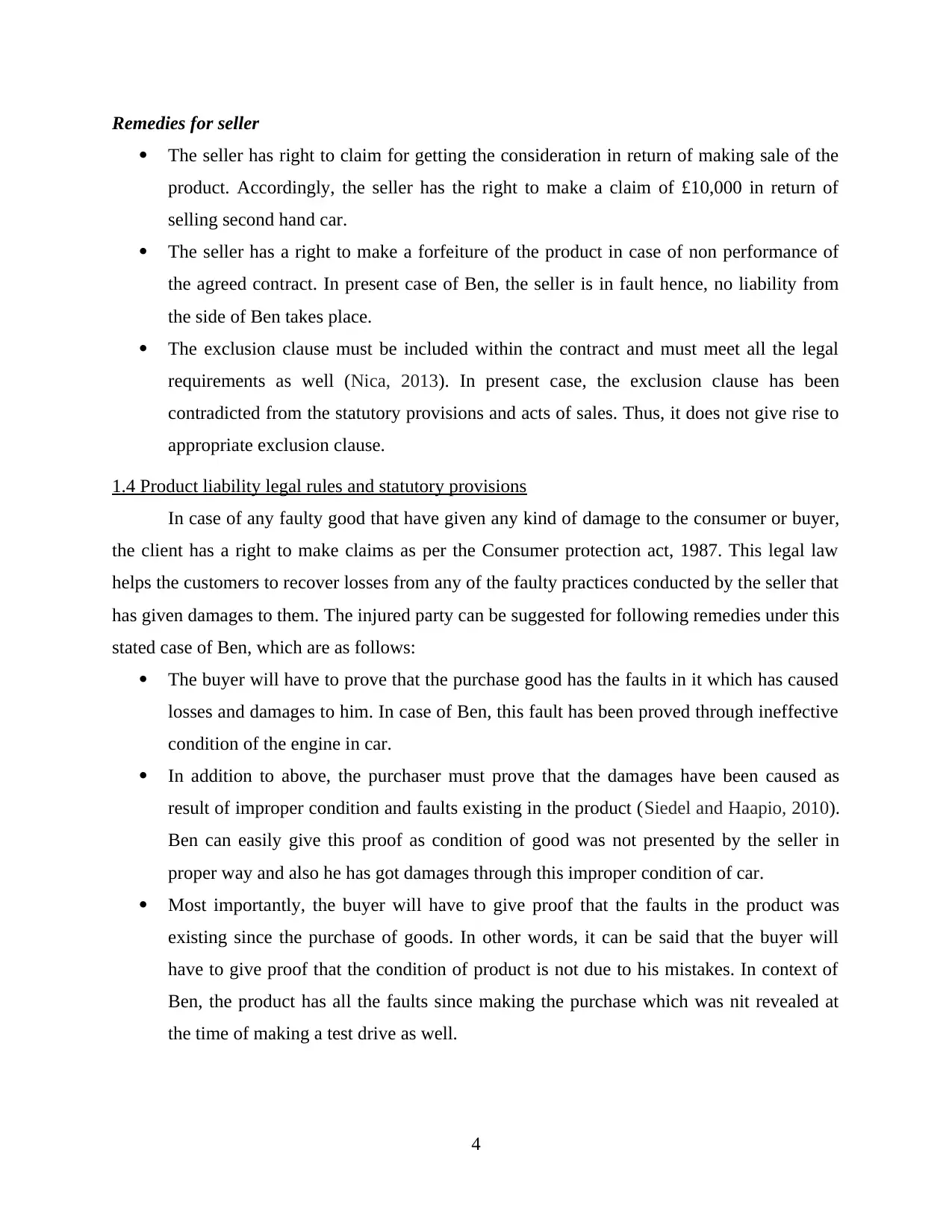
Remedies for seller
The seller has right to claim for getting the consideration in return of making sale of the
product. Accordingly, the seller has the right to make a claim of £10,000 in return of
selling second hand car.
The seller has a right to make a forfeiture of the product in case of non performance of
the agreed contract. In present case of Ben, the seller is in fault hence, no liability from
the side of Ben takes place.
The exclusion clause must be included within the contract and must meet all the legal
requirements as well (Nica, 2013). In present case, the exclusion clause has been
contradicted from the statutory provisions and acts of sales. Thus, it does not give rise to
appropriate exclusion clause.
1.4 Product liability legal rules and statutory provisions
In case of any faulty good that have given any kind of damage to the consumer or buyer,
the client has a right to make claims as per the Consumer protection act, 1987. This legal law
helps the customers to recover losses from any of the faulty practices conducted by the seller that
has given damages to them. The injured party can be suggested for following remedies under this
stated case of Ben, which are as follows:
The buyer will have to prove that the purchase good has the faults in it which has caused
losses and damages to him. In case of Ben, this fault has been proved through ineffective
condition of the engine in car.
In addition to above, the purchaser must prove that the damages have been caused as
result of improper condition and faults existing in the product (Siedel and Haapio, 2010).
Ben can easily give this proof as condition of good was not presented by the seller in
proper way and also he has got damages through this improper condition of car.
Most importantly, the buyer will have to give proof that the faults in the product was
existing since the purchase of goods. In other words, it can be said that the buyer will
have to give proof that the condition of product is not due to his mistakes. In context of
Ben, the product has all the faults since making the purchase which was nit revealed at
the time of making a test drive as well.
4
The seller has right to claim for getting the consideration in return of making sale of the
product. Accordingly, the seller has the right to make a claim of £10,000 in return of
selling second hand car.
The seller has a right to make a forfeiture of the product in case of non performance of
the agreed contract. In present case of Ben, the seller is in fault hence, no liability from
the side of Ben takes place.
The exclusion clause must be included within the contract and must meet all the legal
requirements as well (Nica, 2013). In present case, the exclusion clause has been
contradicted from the statutory provisions and acts of sales. Thus, it does not give rise to
appropriate exclusion clause.
1.4 Product liability legal rules and statutory provisions
In case of any faulty good that have given any kind of damage to the consumer or buyer,
the client has a right to make claims as per the Consumer protection act, 1987. This legal law
helps the customers to recover losses from any of the faulty practices conducted by the seller that
has given damages to them. The injured party can be suggested for following remedies under this
stated case of Ben, which are as follows:
The buyer will have to prove that the purchase good has the faults in it which has caused
losses and damages to him. In case of Ben, this fault has been proved through ineffective
condition of the engine in car.
In addition to above, the purchaser must prove that the damages have been caused as
result of improper condition and faults existing in the product (Siedel and Haapio, 2010).
Ben can easily give this proof as condition of good was not presented by the seller in
proper way and also he has got damages through this improper condition of car.
Most importantly, the buyer will have to give proof that the faults in the product was
existing since the purchase of goods. In other words, it can be said that the buyer will
have to give proof that the condition of product is not due to his mistakes. In context of
Ben, the product has all the faults since making the purchase which was nit revealed at
the time of making a test drive as well.
4
⊘ This is a preview!⊘
Do you want full access?
Subscribe today to unlock all pages.

Trusted by 1+ million students worldwide
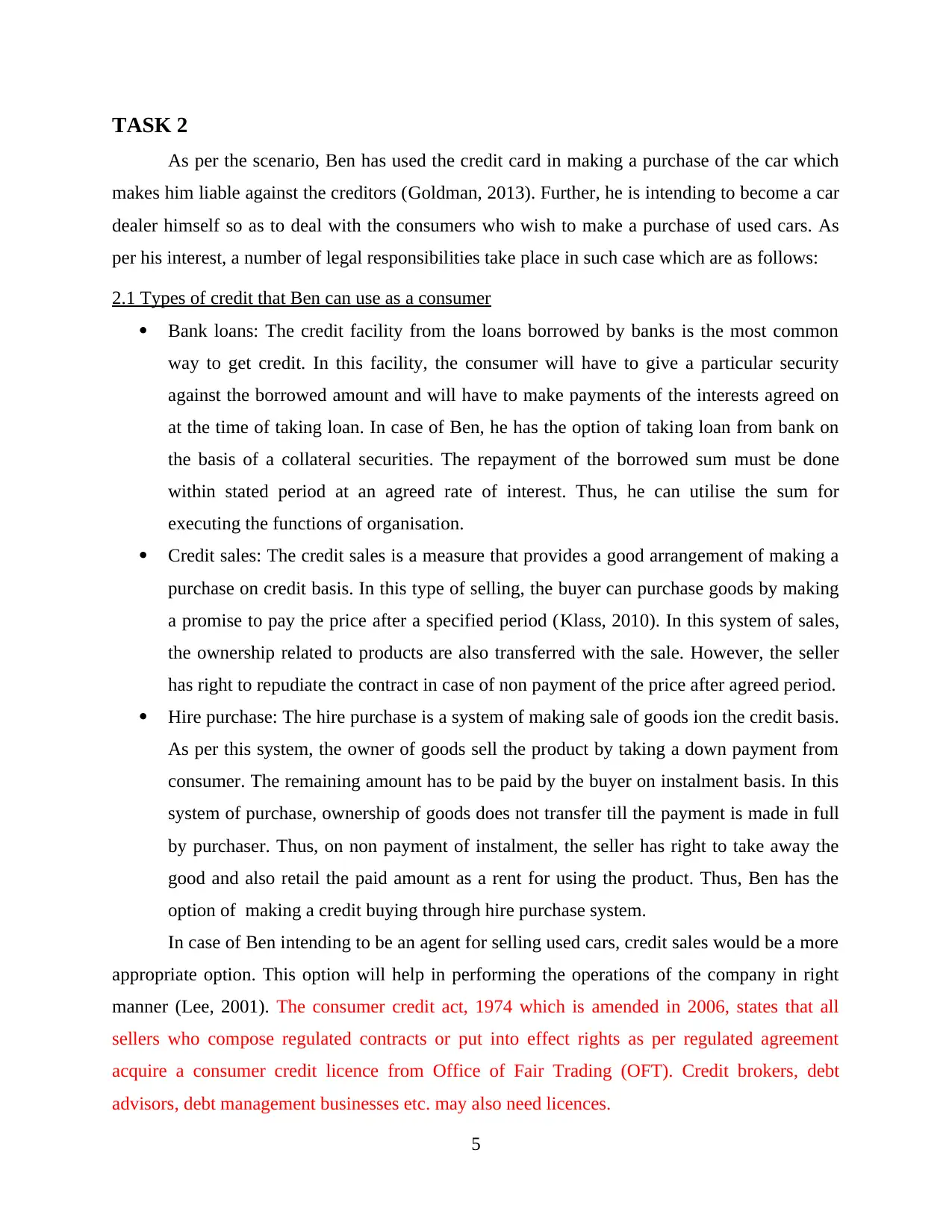
TASK 2
As per the scenario, Ben has used the credit card in making a purchase of the car which
makes him liable against the creditors (Goldman, 2013). Further, he is intending to become a car
dealer himself so as to deal with the consumers who wish to make a purchase of used cars. As
per his interest, a number of legal responsibilities take place in such case which are as follows:
2.1 Types of credit that Ben can use as a consumer
Bank loans: The credit facility from the loans borrowed by banks is the most common
way to get credit. In this facility, the consumer will have to give a particular security
against the borrowed amount and will have to make payments of the interests agreed on
at the time of taking loan. In case of Ben, he has the option of taking loan from bank on
the basis of a collateral securities. The repayment of the borrowed sum must be done
within stated period at an agreed rate of interest. Thus, he can utilise the sum for
executing the functions of organisation.
Credit sales: The credit sales is a measure that provides a good arrangement of making a
purchase on credit basis. In this type of selling, the buyer can purchase goods by making
a promise to pay the price after a specified period (Klass, 2010). In this system of sales,
the ownership related to products are also transferred with the sale. However, the seller
has right to repudiate the contract in case of non payment of the price after agreed period.
Hire purchase: The hire purchase is a system of making sale of goods ion the credit basis.
As per this system, the owner of goods sell the product by taking a down payment from
consumer. The remaining amount has to be paid by the buyer on instalment basis. In this
system of purchase, ownership of goods does not transfer till the payment is made in full
by purchaser. Thus, on non payment of instalment, the seller has right to take away the
good and also retail the paid amount as a rent for using the product. Thus, Ben has the
option of making a credit buying through hire purchase system.
In case of Ben intending to be an agent for selling used cars, credit sales would be a more
appropriate option. This option will help in performing the operations of the company in right
manner (Lee, 2001). The consumer credit act, 1974 which is amended in 2006, states that all
sellers who compose regulated contracts or put into effect rights as per regulated agreement
acquire a consumer credit licence from Office of Fair Trading (OFT). Credit brokers, debt
advisors, debt management businesses etc. may also need licences.
5
As per the scenario, Ben has used the credit card in making a purchase of the car which
makes him liable against the creditors (Goldman, 2013). Further, he is intending to become a car
dealer himself so as to deal with the consumers who wish to make a purchase of used cars. As
per his interest, a number of legal responsibilities take place in such case which are as follows:
2.1 Types of credit that Ben can use as a consumer
Bank loans: The credit facility from the loans borrowed by banks is the most common
way to get credit. In this facility, the consumer will have to give a particular security
against the borrowed amount and will have to make payments of the interests agreed on
at the time of taking loan. In case of Ben, he has the option of taking loan from bank on
the basis of a collateral securities. The repayment of the borrowed sum must be done
within stated period at an agreed rate of interest. Thus, he can utilise the sum for
executing the functions of organisation.
Credit sales: The credit sales is a measure that provides a good arrangement of making a
purchase on credit basis. In this type of selling, the buyer can purchase goods by making
a promise to pay the price after a specified period (Klass, 2010). In this system of sales,
the ownership related to products are also transferred with the sale. However, the seller
has right to repudiate the contract in case of non payment of the price after agreed period.
Hire purchase: The hire purchase is a system of making sale of goods ion the credit basis.
As per this system, the owner of goods sell the product by taking a down payment from
consumer. The remaining amount has to be paid by the buyer on instalment basis. In this
system of purchase, ownership of goods does not transfer till the payment is made in full
by purchaser. Thus, on non payment of instalment, the seller has right to take away the
good and also retail the paid amount as a rent for using the product. Thus, Ben has the
option of making a credit buying through hire purchase system.
In case of Ben intending to be an agent for selling used cars, credit sales would be a more
appropriate option. This option will help in performing the operations of the company in right
manner (Lee, 2001). The consumer credit act, 1974 which is amended in 2006, states that all
sellers who compose regulated contracts or put into effect rights as per regulated agreement
acquire a consumer credit licence from Office of Fair Trading (OFT). Credit brokers, debt
advisors, debt management businesses etc. may also need licences.
5
Paraphrase This Document
Need a fresh take? Get an instant paraphrase of this document with our AI Paraphraser
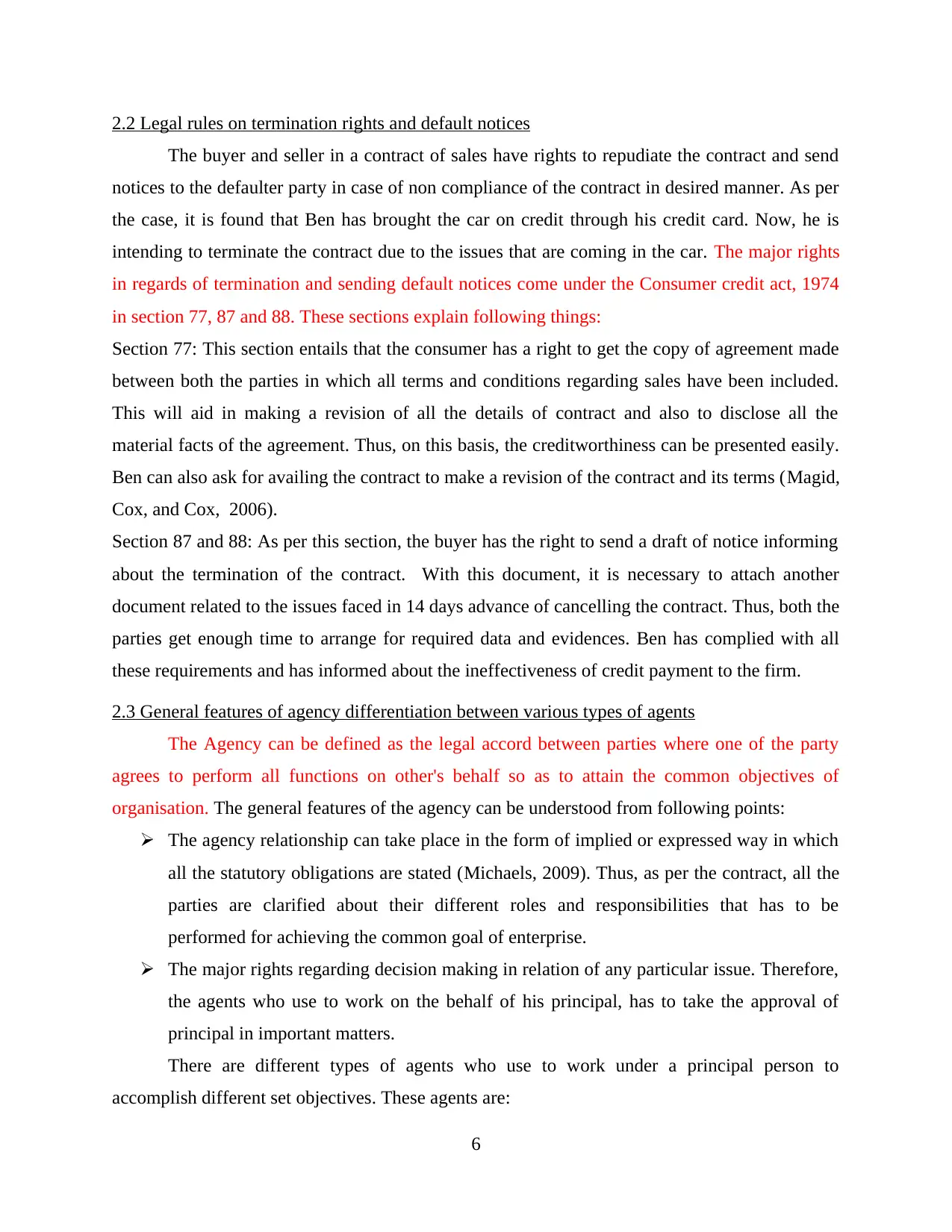
2.2 Legal rules on termination rights and default notices
The buyer and seller in a contract of sales have rights to repudiate the contract and send
notices to the defaulter party in case of non compliance of the contract in desired manner. As per
the case, it is found that Ben has brought the car on credit through his credit card. Now, he is
intending to terminate the contract due to the issues that are coming in the car. The major rights
in regards of termination and sending default notices come under the Consumer credit act, 1974
in section 77, 87 and 88. These sections explain following things:
Section 77: This section entails that the consumer has a right to get the copy of agreement made
between both the parties in which all terms and conditions regarding sales have been included.
This will aid in making a revision of all the details of contract and also to disclose all the
material facts of the agreement. Thus, on this basis, the creditworthiness can be presented easily.
Ben can also ask for availing the contract to make a revision of the contract and its terms (Magid,
Cox, and Cox, 2006).
Section 87 and 88: As per this section, the buyer has the right to send a draft of notice informing
about the termination of the contract. With this document, it is necessary to attach another
document related to the issues faced in 14 days advance of cancelling the contract. Thus, both the
parties get enough time to arrange for required data and evidences. Ben has complied with all
these requirements and has informed about the ineffectiveness of credit payment to the firm.
2.3 General features of agency differentiation between various types of agents
The Agency can be defined as the legal accord between parties where one of the party
agrees to perform all functions on other's behalf so as to attain the common objectives of
organisation. The general features of the agency can be understood from following points:
The agency relationship can take place in the form of implied or expressed way in which
all the statutory obligations are stated (Michaels, 2009). Thus, as per the contract, all the
parties are clarified about their different roles and responsibilities that has to be
performed for achieving the common goal of enterprise.
The major rights regarding decision making in relation of any particular issue. Therefore,
the agents who use to work on the behalf of his principal, has to take the approval of
principal in important matters.
There are different types of agents who use to work under a principal person to
accomplish different set objectives. These agents are:
6
The buyer and seller in a contract of sales have rights to repudiate the contract and send
notices to the defaulter party in case of non compliance of the contract in desired manner. As per
the case, it is found that Ben has brought the car on credit through his credit card. Now, he is
intending to terminate the contract due to the issues that are coming in the car. The major rights
in regards of termination and sending default notices come under the Consumer credit act, 1974
in section 77, 87 and 88. These sections explain following things:
Section 77: This section entails that the consumer has a right to get the copy of agreement made
between both the parties in which all terms and conditions regarding sales have been included.
This will aid in making a revision of all the details of contract and also to disclose all the
material facts of the agreement. Thus, on this basis, the creditworthiness can be presented easily.
Ben can also ask for availing the contract to make a revision of the contract and its terms (Magid,
Cox, and Cox, 2006).
Section 87 and 88: As per this section, the buyer has the right to send a draft of notice informing
about the termination of the contract. With this document, it is necessary to attach another
document related to the issues faced in 14 days advance of cancelling the contract. Thus, both the
parties get enough time to arrange for required data and evidences. Ben has complied with all
these requirements and has informed about the ineffectiveness of credit payment to the firm.
2.3 General features of agency differentiation between various types of agents
The Agency can be defined as the legal accord between parties where one of the party
agrees to perform all functions on other's behalf so as to attain the common objectives of
organisation. The general features of the agency can be understood from following points:
The agency relationship can take place in the form of implied or expressed way in which
all the statutory obligations are stated (Michaels, 2009). Thus, as per the contract, all the
parties are clarified about their different roles and responsibilities that has to be
performed for achieving the common goal of enterprise.
The major rights regarding decision making in relation of any particular issue. Therefore,
the agents who use to work on the behalf of his principal, has to take the approval of
principal in important matters.
There are different types of agents who use to work under a principal person to
accomplish different set objectives. These agents are:
6
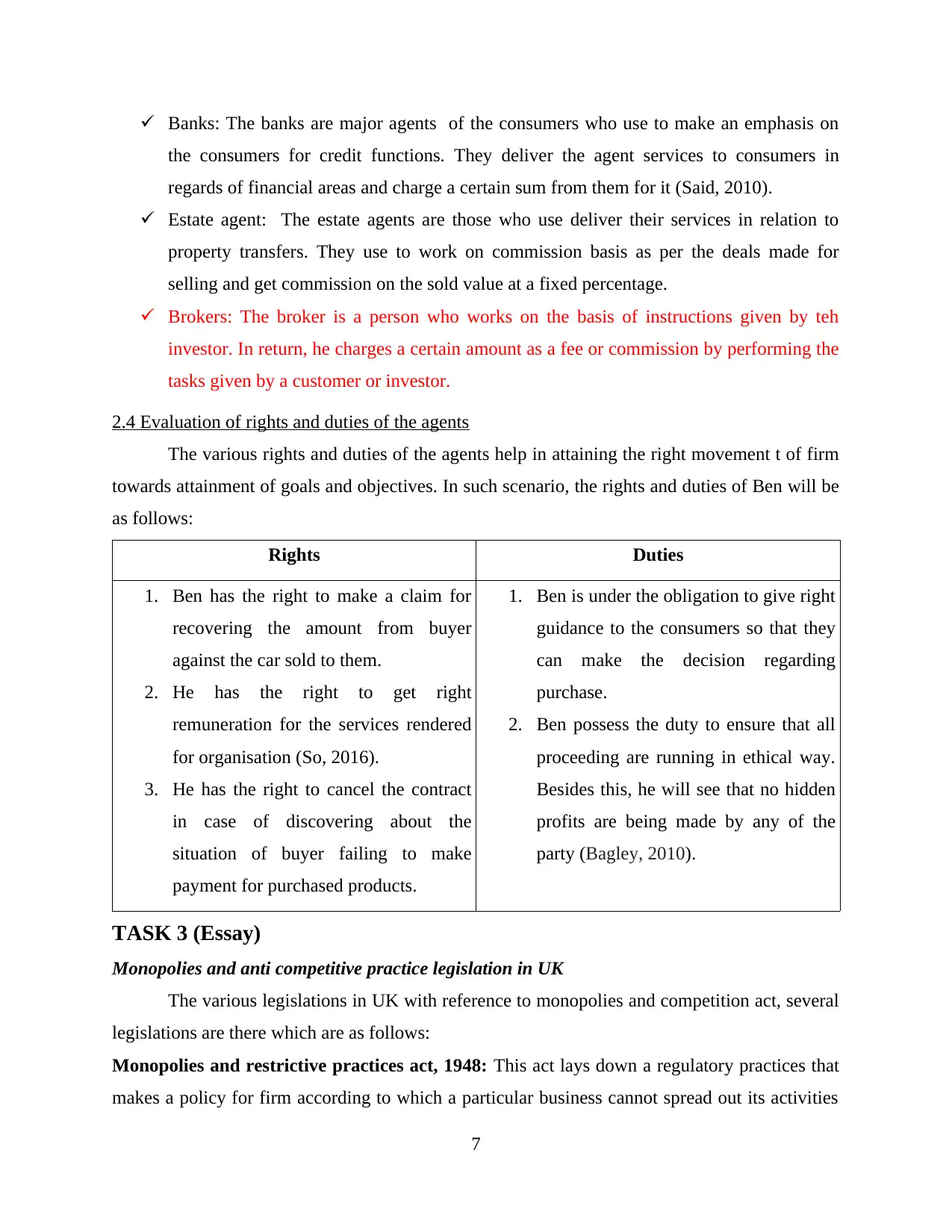
Banks: The banks are major agents of the consumers who use to make an emphasis on
the consumers for credit functions. They deliver the agent services to consumers in
regards of financial areas and charge a certain sum from them for it (Said, 2010).
Estate agent: The estate agents are those who use deliver their services in relation to
property transfers. They use to work on commission basis as per the deals made for
selling and get commission on the sold value at a fixed percentage.
Brokers: The broker is a person who works on the basis of instructions given by teh
investor. In return, he charges a certain amount as a fee or commission by performing the
tasks given by a customer or investor.
2.4 Evaluation of rights and duties of the agents
The various rights and duties of the agents help in attaining the right movement t of firm
towards attainment of goals and objectives. In such scenario, the rights and duties of Ben will be
as follows:
Rights Duties
1. Ben has the right to make a claim for
recovering the amount from buyer
against the car sold to them.
2. He has the right to get right
remuneration for the services rendered
for organisation (So, 2016).
3. He has the right to cancel the contract
in case of discovering about the
situation of buyer failing to make
payment for purchased products.
1. Ben is under the obligation to give right
guidance to the consumers so that they
can make the decision regarding
purchase.
2. Ben possess the duty to ensure that all
proceeding are running in ethical way.
Besides this, he will see that no hidden
profits are being made by any of the
party (Bagley, 2010).
TASK 3 (Essay)
Monopolies and anti competitive practice legislation in UK
The various legislations in UK with reference to monopolies and competition act, several
legislations are there which are as follows:
Monopolies and restrictive practices act, 1948: This act lays down a regulatory practices that
makes a policy for firm according to which a particular business cannot spread out its activities
7
the consumers for credit functions. They deliver the agent services to consumers in
regards of financial areas and charge a certain sum from them for it (Said, 2010).
Estate agent: The estate agents are those who use deliver their services in relation to
property transfers. They use to work on commission basis as per the deals made for
selling and get commission on the sold value at a fixed percentage.
Brokers: The broker is a person who works on the basis of instructions given by teh
investor. In return, he charges a certain amount as a fee or commission by performing the
tasks given by a customer or investor.
2.4 Evaluation of rights and duties of the agents
The various rights and duties of the agents help in attaining the right movement t of firm
towards attainment of goals and objectives. In such scenario, the rights and duties of Ben will be
as follows:
Rights Duties
1. Ben has the right to make a claim for
recovering the amount from buyer
against the car sold to them.
2. He has the right to get right
remuneration for the services rendered
for organisation (So, 2016).
3. He has the right to cancel the contract
in case of discovering about the
situation of buyer failing to make
payment for purchased products.
1. Ben is under the obligation to give right
guidance to the consumers so that they
can make the decision regarding
purchase.
2. Ben possess the duty to ensure that all
proceeding are running in ethical way.
Besides this, he will see that no hidden
profits are being made by any of the
party (Bagley, 2010).
TASK 3 (Essay)
Monopolies and anti competitive practice legislation in UK
The various legislations in UK with reference to monopolies and competition act, several
legislations are there which are as follows:
Monopolies and restrictive practices act, 1948: This act lays down a regulatory practices that
makes a policy for firm according to which a particular business cannot spread out its activities
7
⊘ This is a preview!⊘
Do you want full access?
Subscribe today to unlock all pages.

Trusted by 1+ million students worldwide
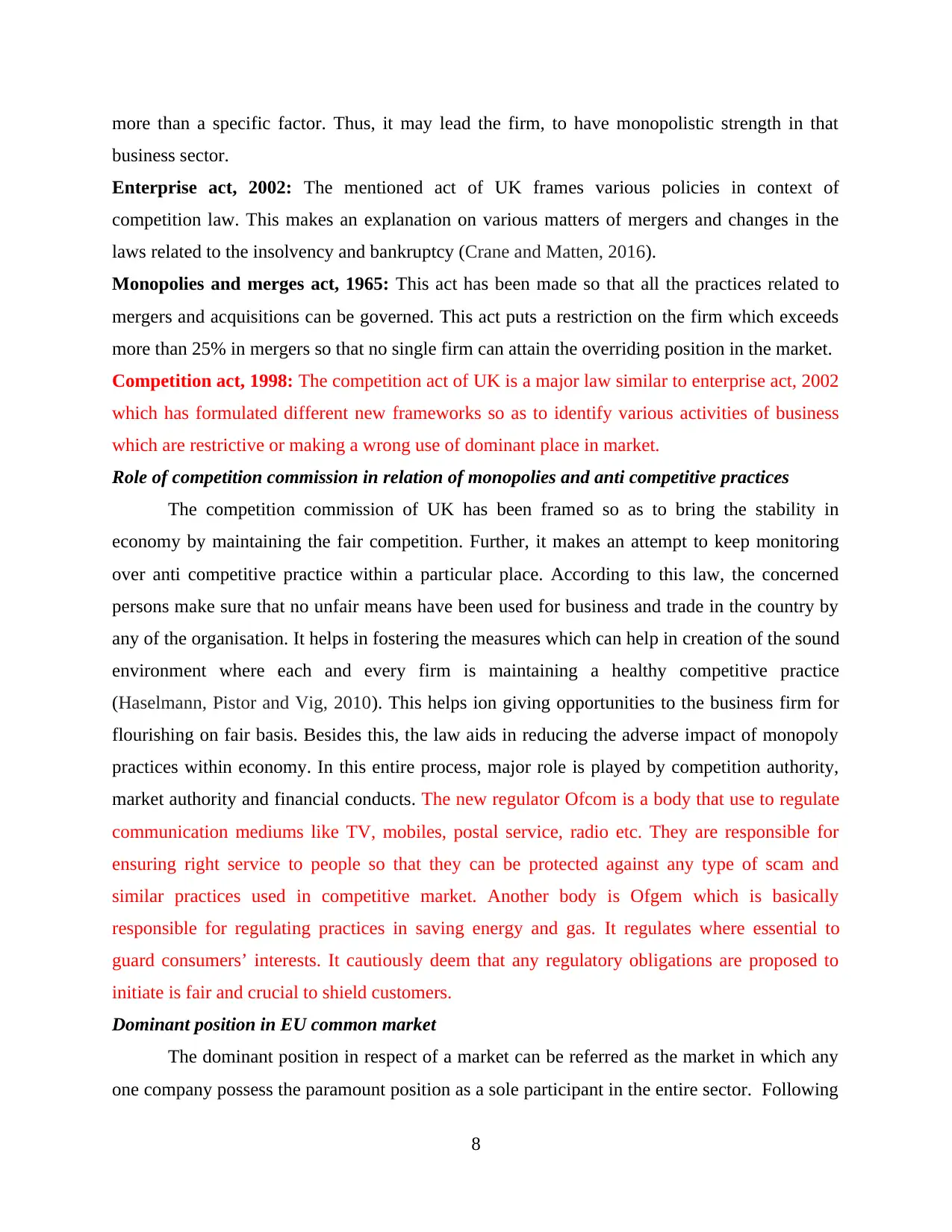
more than a specific factor. Thus, it may lead the firm, to have monopolistic strength in that
business sector.
Enterprise act, 2002: The mentioned act of UK frames various policies in context of
competition law. This makes an explanation on various matters of mergers and changes in the
laws related to the insolvency and bankruptcy (Crane and Matten, 2016).
Monopolies and merges act, 1965: This act has been made so that all the practices related to
mergers and acquisitions can be governed. This act puts a restriction on the firm which exceeds
more than 25% in mergers so that no single firm can attain the overriding position in the market.
Competition act, 1998: The competition act of UK is a major law similar to enterprise act, 2002
which has formulated different new frameworks so as to identify various activities of business
which are restrictive or making a wrong use of dominant place in market.
Role of competition commission in relation of monopolies and anti competitive practices
The competition commission of UK has been framed so as to bring the stability in
economy by maintaining the fair competition. Further, it makes an attempt to keep monitoring
over anti competitive practice within a particular place. According to this law, the concerned
persons make sure that no unfair means have been used for business and trade in the country by
any of the organisation. It helps in fostering the measures which can help in creation of the sound
environment where each and every firm is maintaining a healthy competitive practice
(Haselmann, Pistor and Vig, 2010). This helps ion giving opportunities to the business firm for
flourishing on fair basis. Besides this, the law aids in reducing the adverse impact of monopoly
practices within economy. In this entire process, major role is played by competition authority,
market authority and financial conducts. The new regulator Ofcom is a body that use to regulate
communication mediums like TV, mobiles, postal service, radio etc. They are responsible for
ensuring right service to people so that they can be protected against any type of scam and
similar practices used in competitive market. Another body is Ofgem which is basically
responsible for regulating practices in saving energy and gas. It regulates where essential to
guard consumers’ interests. It cautiously deem that any regulatory obligations are proposed to
initiate is fair and crucial to shield customers.
Dominant position in EU common market
The dominant position in respect of a market can be referred as the market in which any
one company possess the paramount position as a sole participant in the entire sector. Following
8
business sector.
Enterprise act, 2002: The mentioned act of UK frames various policies in context of
competition law. This makes an explanation on various matters of mergers and changes in the
laws related to the insolvency and bankruptcy (Crane and Matten, 2016).
Monopolies and merges act, 1965: This act has been made so that all the practices related to
mergers and acquisitions can be governed. This act puts a restriction on the firm which exceeds
more than 25% in mergers so that no single firm can attain the overriding position in the market.
Competition act, 1998: The competition act of UK is a major law similar to enterprise act, 2002
which has formulated different new frameworks so as to identify various activities of business
which are restrictive or making a wrong use of dominant place in market.
Role of competition commission in relation of monopolies and anti competitive practices
The competition commission of UK has been framed so as to bring the stability in
economy by maintaining the fair competition. Further, it makes an attempt to keep monitoring
over anti competitive practice within a particular place. According to this law, the concerned
persons make sure that no unfair means have been used for business and trade in the country by
any of the organisation. It helps in fostering the measures which can help in creation of the sound
environment where each and every firm is maintaining a healthy competitive practice
(Haselmann, Pistor and Vig, 2010). This helps ion giving opportunities to the business firm for
flourishing on fair basis. Besides this, the law aids in reducing the adverse impact of monopoly
practices within economy. In this entire process, major role is played by competition authority,
market authority and financial conducts. The new regulator Ofcom is a body that use to regulate
communication mediums like TV, mobiles, postal service, radio etc. They are responsible for
ensuring right service to people so that they can be protected against any type of scam and
similar practices used in competitive market. Another body is Ofgem which is basically
responsible for regulating practices in saving energy and gas. It regulates where essential to
guard consumers’ interests. It cautiously deem that any regulatory obligations are proposed to
initiate is fair and crucial to shield customers.
Dominant position in EU common market
The dominant position in respect of a market can be referred as the market in which any
one company possess the paramount position as a sole participant in the entire sector. Following
8
Paraphrase This Document
Need a fresh take? Get an instant paraphrase of this document with our AI Paraphraser
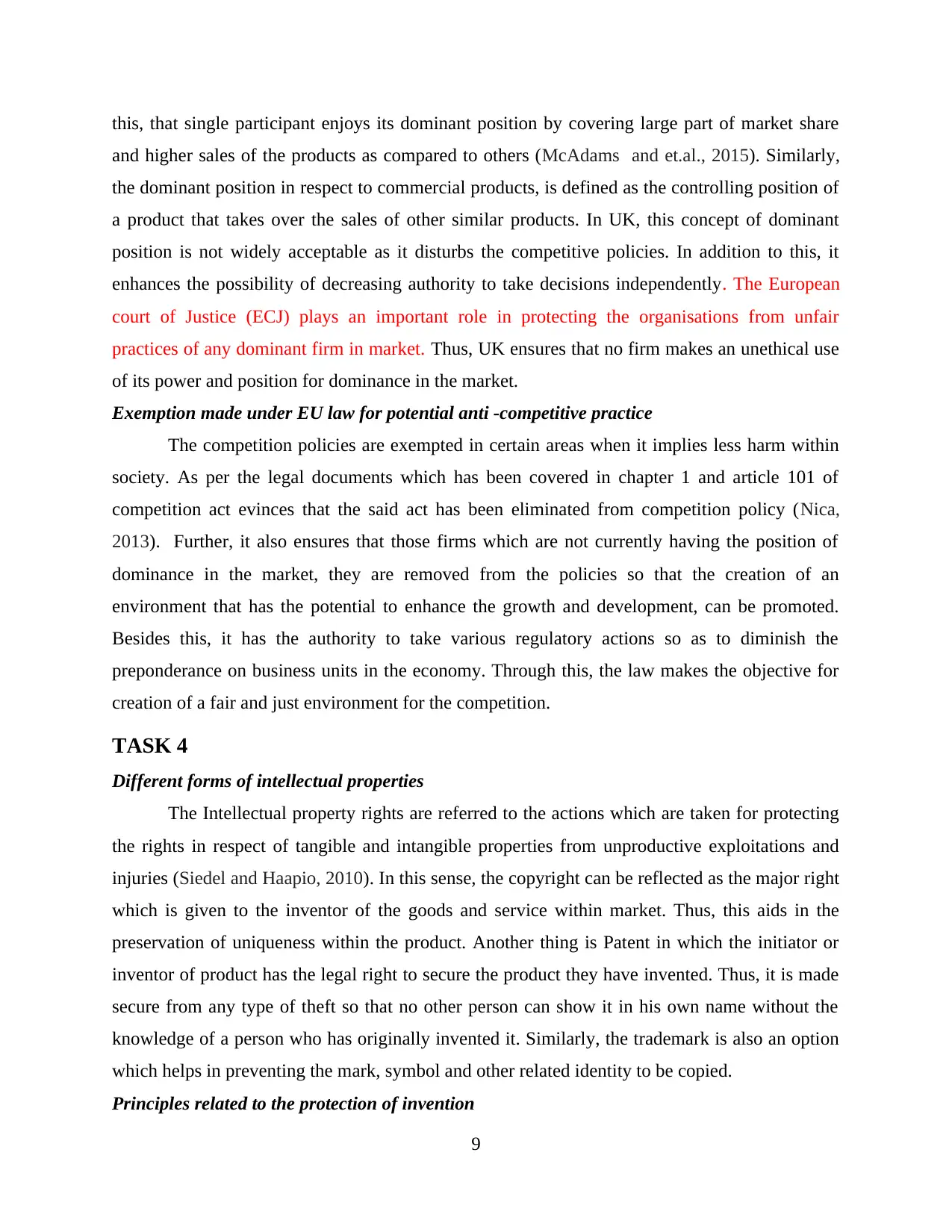
this, that single participant enjoys its dominant position by covering large part of market share
and higher sales of the products as compared to others (McAdams and et.al., 2015). Similarly,
the dominant position in respect to commercial products, is defined as the controlling position of
a product that takes over the sales of other similar products. In UK, this concept of dominant
position is not widely acceptable as it disturbs the competitive policies. In addition to this, it
enhances the possibility of decreasing authority to take decisions independently. The European
court of Justice (ECJ) plays an important role in protecting the organisations from unfair
practices of any dominant firm in market. Thus, UK ensures that no firm makes an unethical use
of its power and position for dominance in the market.
Exemption made under EU law for potential anti -competitive practice
The competition policies are exempted in certain areas when it implies less harm within
society. As per the legal documents which has been covered in chapter 1 and article 101 of
competition act evinces that the said act has been eliminated from competition policy (Nica,
2013). Further, it also ensures that those firms which are not currently having the position of
dominance in the market, they are removed from the policies so that the creation of an
environment that has the potential to enhance the growth and development, can be promoted.
Besides this, it has the authority to take various regulatory actions so as to diminish the
preponderance on business units in the economy. Through this, the law makes the objective for
creation of a fair and just environment for the competition.
TASK 4
Different forms of intellectual properties
The Intellectual property rights are referred to the actions which are taken for protecting
the rights in respect of tangible and intangible properties from unproductive exploitations and
injuries (Siedel and Haapio, 2010). In this sense, the copyright can be reflected as the major right
which is given to the inventor of the goods and service within market. Thus, this aids in the
preservation of uniqueness within the product. Another thing is Patent in which the initiator or
inventor of product has the legal right to secure the product they have invented. Thus, it is made
secure from any type of theft so that no other person can show it in his own name without the
knowledge of a person who has originally invented it. Similarly, the trademark is also an option
which helps in preventing the mark, symbol and other related identity to be copied.
Principles related to the protection of invention
9
and higher sales of the products as compared to others (McAdams and et.al., 2015). Similarly,
the dominant position in respect to commercial products, is defined as the controlling position of
a product that takes over the sales of other similar products. In UK, this concept of dominant
position is not widely acceptable as it disturbs the competitive policies. In addition to this, it
enhances the possibility of decreasing authority to take decisions independently. The European
court of Justice (ECJ) plays an important role in protecting the organisations from unfair
practices of any dominant firm in market. Thus, UK ensures that no firm makes an unethical use
of its power and position for dominance in the market.
Exemption made under EU law for potential anti -competitive practice
The competition policies are exempted in certain areas when it implies less harm within
society. As per the legal documents which has been covered in chapter 1 and article 101 of
competition act evinces that the said act has been eliminated from competition policy (Nica,
2013). Further, it also ensures that those firms which are not currently having the position of
dominance in the market, they are removed from the policies so that the creation of an
environment that has the potential to enhance the growth and development, can be promoted.
Besides this, it has the authority to take various regulatory actions so as to diminish the
preponderance on business units in the economy. Through this, the law makes the objective for
creation of a fair and just environment for the competition.
TASK 4
Different forms of intellectual properties
The Intellectual property rights are referred to the actions which are taken for protecting
the rights in respect of tangible and intangible properties from unproductive exploitations and
injuries (Siedel and Haapio, 2010). In this sense, the copyright can be reflected as the major right
which is given to the inventor of the goods and service within market. Thus, this aids in the
preservation of uniqueness within the product. Another thing is Patent in which the initiator or
inventor of product has the legal right to secure the product they have invented. Thus, it is made
secure from any type of theft so that no other person can show it in his own name without the
knowledge of a person who has originally invented it. Similarly, the trademark is also an option
which helps in preventing the mark, symbol and other related identity to be copied.
Principles related to the protection of invention
9
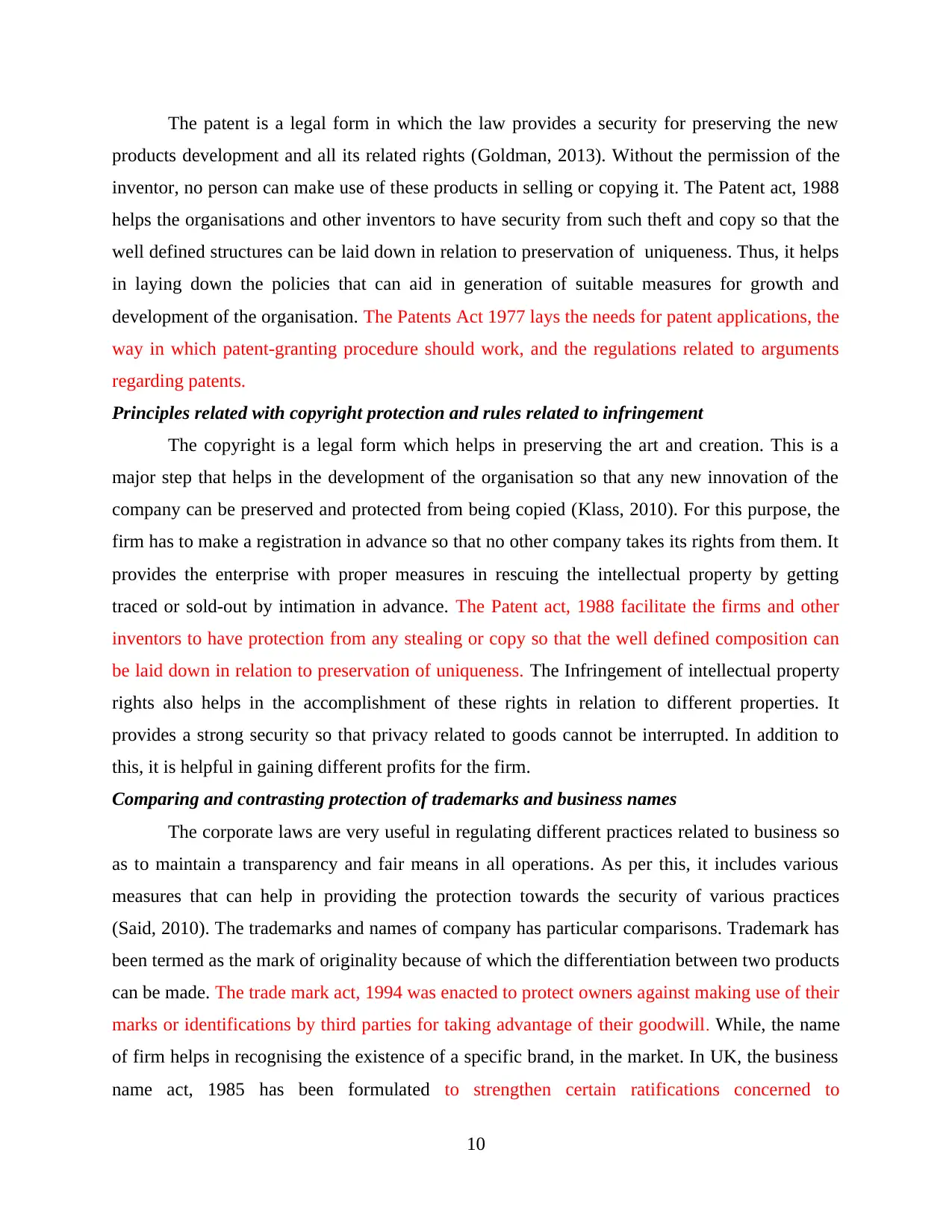
The patent is a legal form in which the law provides a security for preserving the new
products development and all its related rights (Goldman, 2013). Without the permission of the
inventor, no person can make use of these products in selling or copying it. The Patent act, 1988
helps the organisations and other inventors to have security from such theft and copy so that the
well defined structures can be laid down in relation to preservation of uniqueness. Thus, it helps
in laying down the policies that can aid in generation of suitable measures for growth and
development of the organisation. The Patents Act 1977 lays the needs for patent applications, the
way in which patent-granting procedure should work, and the regulations related to arguments
regarding patents.
Principles related with copyright protection and rules related to infringement
The copyright is a legal form which helps in preserving the art and creation. This is a
major step that helps in the development of the organisation so that any new innovation of the
company can be preserved and protected from being copied (Klass, 2010). For this purpose, the
firm has to make a registration in advance so that no other company takes its rights from them. It
provides the enterprise with proper measures in rescuing the intellectual property by getting
traced or sold-out by intimation in advance. The Patent act, 1988 facilitate the firms and other
inventors to have protection from any stealing or copy so that the well defined composition can
be laid down in relation to preservation of uniqueness. The Infringement of intellectual property
rights also helps in the accomplishment of these rights in relation to different properties. It
provides a strong security so that privacy related to goods cannot be interrupted. In addition to
this, it is helpful in gaining different profits for the firm.
Comparing and contrasting protection of trademarks and business names
The corporate laws are very useful in regulating different practices related to business so
as to maintain a transparency and fair means in all operations. As per this, it includes various
measures that can help in providing the protection towards the security of various practices
(Said, 2010). The trademarks and names of company has particular comparisons. Trademark has
been termed as the mark of originality because of which the differentiation between two products
can be made. The trade mark act, 1994 was enacted to protect owners against making use of their
marks or identifications by third parties for taking advantage of their goodwill. While, the name
of firm helps in recognising the existence of a specific brand, in the market. In UK, the business
name act, 1985 has been formulated to strengthen certain ratifications concerned to
10
products development and all its related rights (Goldman, 2013). Without the permission of the
inventor, no person can make use of these products in selling or copying it. The Patent act, 1988
helps the organisations and other inventors to have security from such theft and copy so that the
well defined structures can be laid down in relation to preservation of uniqueness. Thus, it helps
in laying down the policies that can aid in generation of suitable measures for growth and
development of the organisation. The Patents Act 1977 lays the needs for patent applications, the
way in which patent-granting procedure should work, and the regulations related to arguments
regarding patents.
Principles related with copyright protection and rules related to infringement
The copyright is a legal form which helps in preserving the art and creation. This is a
major step that helps in the development of the organisation so that any new innovation of the
company can be preserved and protected from being copied (Klass, 2010). For this purpose, the
firm has to make a registration in advance so that no other company takes its rights from them. It
provides the enterprise with proper measures in rescuing the intellectual property by getting
traced or sold-out by intimation in advance. The Patent act, 1988 facilitate the firms and other
inventors to have protection from any stealing or copy so that the well defined composition can
be laid down in relation to preservation of uniqueness. The Infringement of intellectual property
rights also helps in the accomplishment of these rights in relation to different properties. It
provides a strong security so that privacy related to goods cannot be interrupted. In addition to
this, it is helpful in gaining different profits for the firm.
Comparing and contrasting protection of trademarks and business names
The corporate laws are very useful in regulating different practices related to business so
as to maintain a transparency and fair means in all operations. As per this, it includes various
measures that can help in providing the protection towards the security of various practices
(Said, 2010). The trademarks and names of company has particular comparisons. Trademark has
been termed as the mark of originality because of which the differentiation between two products
can be made. The trade mark act, 1994 was enacted to protect owners against making use of their
marks or identifications by third parties for taking advantage of their goodwill. While, the name
of firm helps in recognising the existence of a specific brand, in the market. In UK, the business
name act, 1985 has been formulated to strengthen certain ratifications concerned to
10
⊘ This is a preview!⊘
Do you want full access?
Subscribe today to unlock all pages.

Trusted by 1+ million students worldwide
1 out of 14
Related Documents
Your All-in-One AI-Powered Toolkit for Academic Success.
+13062052269
info@desklib.com
Available 24*7 on WhatsApp / Email
![[object Object]](/_next/static/media/star-bottom.7253800d.svg)
Unlock your academic potential
Copyright © 2020–2025 A2Z Services. All Rights Reserved. Developed and managed by ZUCOL.





